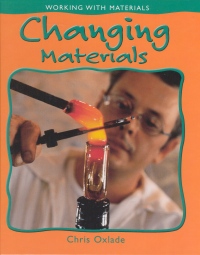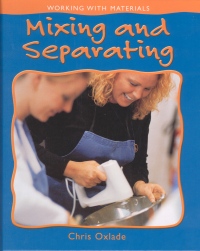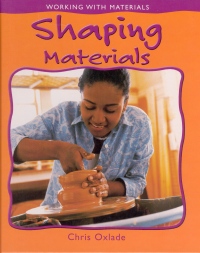| ________________
CM . . .
. Volume XIV Number 18. . . .May 2, 2008 
 |
Changing Materials. (Working with Materials).
Chris Oxlade.
St. Catharines, ON: Crabtree, 2008.
32 pp., pbk. & hc., $10.95 (pbk.), $20.76 (rlb.).
ISBN 978-0-7787-3648-6 (pbk.), ISBN 978-0-7787-3638-7 (rlb.).
Subject Headings:
Chemical reactions-Juvenile literature.
Chemical reactions-Experiments-Juvenile literature.
Change of state (Physics)-Juvenile literature.
Strength of materials-Juvenile literature.
Grades 2-3 / Ages 7-8.
Review by Gail Hamilton.
*** /4
|
| |
|
 |
Joining Materials. (Working with Materials).
Chris Oxlade.
St. Catharines, ON: Crabtree, 2008.
32 pp., pbk. & hc., $10.95 (pbk.), $20.76 (rlb.).
ISBN 978-0-7787-3649-3 (pbk.), ISBN 978-0-7787-3639-4 (rlb.).
Subject Headings:
Materials-Juvenile literature.
Materials-Experiments-Juvenile literature.
Joints (Engineering)-Materials-Juvenile literature.
Grades 2-3 / Ages 7-8.
Review by Gail Hamilton.
*** /4 |
| |
|
 |
Mixing and Separating. (Working with Materials).
Chris Oxlade.
St. Catharines, ON: Crabtree, 2008.
32 pp., pbk. & hc., $10.95 (pbk.), $20.76 (rlb.).
ISBN 978-0-7787-3650-9 (pbk.), ISBN 978-0-7787-3640-0 (rlb.).
Subject Headings:
Mixtures-Juvenile literature.
Mixtures-Experiments-Juvenile literature.
Separation (Technology)-Juvenile literature.
Separation (Technology)-Experiments-Juvenile literature.
Matter-Properties-Juvenile literature.
Grades 2-3 / Ages 7-8.
Review by Gail Hamilton.
*** /4 |
| |
|
 |
Shaping Materials. (Working with Materials).
Chris Oxlade.
St. Catharines, ON: Crabtree, 2008.
32 pp., pbk. & hc., $10.95 (pbk.), $20.76 (rlb.).
ISBN 978-0-7787-3651-6 (pbk.), ISBN 978-0-7787-3641-7 (rlb.).
Subject Headings:
Materials-Juvenile literature.
Materials-Experiments-Juvenile literature.
Grades 2-3 / Ages 7-8.
Review by Gail Hamilton.
*** /4 |
| |
|

excerpt:
A blacksmith makes items, such as horseshoes and garden gates, from iron. The blacksmith heats up the iron. This makes the iron softer and easier for the blacksmith to hammer into shape.
Thin sheets of metal, such as steel, are made by rollers. The metal starts as a block. The metal is heated to make it easier to roll. It goes through many rollers. It gradually gets thinner and thinner. (From Shaping Materials.)
The four-volume "Working with Materials" series introduces young readers to the properties of materials and provides them with an opportunity to conduct a few experiments to demonstrate the concepts in each title. These experiments can be conducted using commonly found household objects. Each book consists of 12 chapters, a table of contents, a glossary, an index and a list of resources for further study- books, websites and places to visit (the only problem is that all of the places to visit are in the United States). "It's a fact!" boxes give additional information. The text is rather repetitive and the sentences brief, but the illustrations, consisting of colour photographs and drawings, are excellent and will help readers to better understand the scientific concepts presented.
Changing Materials explains to children how various methods, such as bending, breaking, melting, boiling, dissolving and burning, can alter materials temporarily (as is the case when ice is melted and then the water is refrozen) or permanently (for instance, when an egg is fried). There are three experiments to try: making salt crystals, making plastic, and "Weather in a Bag" - learning about condensation and evaporation by changing the states of water.
Joining Materials features the many ways in which both hard and soft materials can be put together- through the use of nuts, bolts and screws, strong glue, welding and soldering, sewing, stapling, taping, and special joints for wood (e.g. dovetail and miter joints). Of the four titles in the series, this one, perhaps, is the least useful for young children. Two of the activities at the back of the book are related: readers will first make flour and water glue and then use the glue in a papier-mâché art activity. The other project is the creation of a picture frame using a CD jewel case.
Mixing and Separating begins with the definition of a mixture, followed by examples of types of solutions. The basic premise is that, if one knows the properties of a material, it is easier to determine the best method of separating it from a mixture. Methods discussed in this title include sieving, settling and skimming, filtering, and evaporation. Readers will also learn that new materials can be created by combining, one example being the combining of Plaster of Paris powder with water to make a cast. Two of the experiments deal with separating materials (magnetism and settling), while the third focuses on mixing (making a fruit smoothie out of fruit, juice and yogurt).
Shaping Materials highlights the methods used to change the shape and appearance of materials such as wood, metal, clay and paper. Depending on the properties of the materials, the methods include cutting and carving (marble and wood sculptures), folding (origami), bending (in the manufacture of sneakers), molding (Jell-o), heating (glass), hammering (horseshoes) and rolling (sheet metal). The various tools of the trade are shown. Instructions are provided for making ice molds, a folded box and decorative butterflies.
Recommended.
Gail Hamilton is a teacher-librarian in Winnipeg, MB.

To comment
on this title or this review, send mail to cm@umanitoba.ca.
Copyright © the Manitoba Library Association. Reproduction for personal
use is permitted only if this copyright notice is maintained. Any
other reproduction is prohibited without permission.
NEXT REVIEW |
TABLE OF CONTENTS FOR THIS ISSUE
- May 2, 2008.
AUTHORS |
TITLES |
MEDIA REVIEWS |
PROFILES |
BACK ISSUES |
SEARCH |
CMARCHIVE |
HOME |



